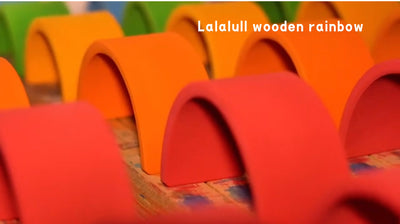Wooden Rainbow stackers are a timeless, versatile toy that can provide endless hours of creative play and developmental benefits for children. However, with so many options available, it can be challenging to choose the best one for your child. In this blog post, we'll guide you through the essential factors to consider when selecting a wooden rainbow stacker to ensure you make a choice that will be both enjoyable and beneficial for your little one.
1. Consider the Size and Number of Pieces
The size and number of pieces in a Wooden Rainbow stacker can significantly impact how your child interacts with it.
- Size: Smaller stackers are great for younger children who are just developing their motor skills, while larger stackers can provide more complex challenges for older kids.
- Number of Pieces: A stacker with more pieces offers greater versatility and complexity, encouraging your child to think creatively and problem-solve. However, for very young children, fewer pieces might be more manageable and less overwhelming.
2. Check the Material and Quality
The quality of the materials used in a wooden rainbow stacker is crucial for both safety and durability.
- Material: Ensure the stacker is made from high-quality, non-toxic wood. Look for certifications like FSC (Forest Stewardship Council) that indicate sustainable and safe practices. Hardwood (Basswood, limewood, rubberwood, etc ) is normally more durable and therefore expensive than the softwood (Pinewood)
- Finish: The wood should be smooth with no rough edges or splinters. A non-toxic water-stain is normally better and more expensive than paint or other finish is essential to prevent any harmful chemicals from coming into contact with your child.
- Recommend brand: Grimms & LaLaLull (Both brand adopt hardwood & handcraft water stain for every rainbow product)
3. Evaluate the Colors and Design
The colors and design of a wooden rainbow stacker can influence how engaging and educational it is for your child.
- Colors: Bright, vibrant colors are visually stimulating and can help children learn color recognition. Ensure the paints used are non-toxic and safe for children.
- Design: Some stackers have additional features such as varying shapes or textures. Consider whether these elements will add value to your child's play experience.
4. Assess Age Appropriateness
Selecting a stacker that matches your child's developmental stage is essential for maximizing its benefits.
- Age Range: Check the manufacturer's recommended age range to ensure the stacker is suitable for your child's age and skill level.
- Developmental Benefits: For younger children, simpler stackers that focus on basic motor skills might be best. Older children may benefit more from stackers that encourage problem-solving and imaginative play.
5. Consider the Educational Value
Wooden Rainbow stackers can be more than just a toy; they can also be an educational tool.
- Learning Opportunities: Look for stackers that offer various ways to play and learn. For instance, stackers that can be used to teach concepts like size, order, and balance, or that can be incorporated into imaginative play scenarios, provide added educational value.
- Versatility: A versatile stacker that can be used in multiple ways will grow with your child, providing long-term engagement and learning opportunities.
6. Read Reviews and Recommendations
Before making a purchase, it's helpful to read reviews from other parents and caregivers.
- Customer Reviews: Look for reviews that mention the stacker's durability, safety, and how much their children enjoyed playing with it.
- Expert Recommendations: Consult lists of top-rated wooden rainbow stackers from reputable parenting websites or child development experts.
7. Set a Budget
Wooden rainbow stackers can vary widely in price, so it's important to set a budget that works for you.
- Value for Money: While it's tempting to go for the cheapest option, investing in a high-quality stacker can provide better value in the long run due to its durability and safety.
- Price vs. Features: Compare different stackers within your budget to see which offers the best combination of quality, educational value, and play potential.
Conclusion
Choosing the best Wooden Rainbow stacker for your child involves considering several factors, including size, material, design, age appropriateness, educational value, and budget. By taking the time to evaluate these aspects, you can select a stacker that will not only provide hours of fun but also support your child's developmental journey. A well-chosen wooden rainbow stacker is an investment in your child's growth, creativity, and learning.






